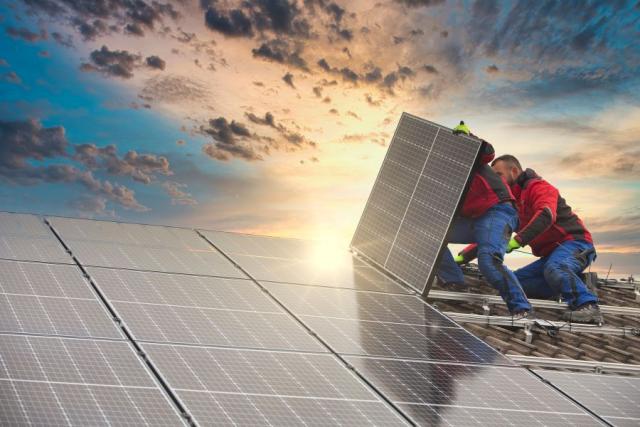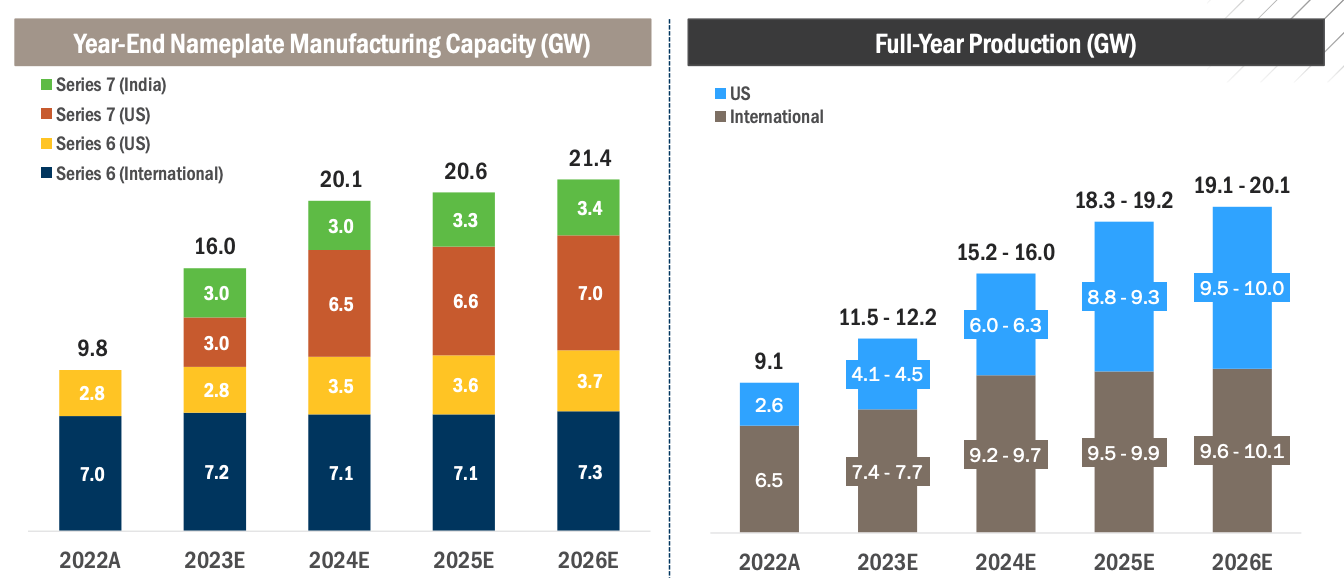
(Source: Shutterstock.com)
As the Inflation Reduction Act (IRA) opens incentives for domestic manufacturers of solar panels, First Solar positions itself for more growth, having sold out of planned production through 2025.
First Solar has been sealing long-term multiyear procurement arrangements for modules with renewable energy companies as the company continues to crank out solar panels. First Solar has also been busy constructing new facilities, including in the U.S. and India, to meet robust demand.
Moving deeper into 2023 with a “record backlog of orders and a manufacturing capacity growth plan that is well underway,” the outlook appears favorable for the largest utility-scale solar panel manufacturer in the U.S., according to First Solar CEO Mark Widmar.
“We are on track to add 6.2 gigawatts [GW] of global nameplate manufacturing capacity this year as our new Series 7 factories come online in the U.S. and India. We expect to exit 2023 with 16 gigawatts of annual nameplate capacity,” Widmar said Feb. 28 on the company’s latest earnings call. “We also expect 2023 to be a pivotal year as we build on the foundations established in 2022 to scale manufacturing, invest in R&D and evolve our technology and product road maps.”
The work is being carried out as the solar sector makes way for federal tax incentives courtesy of the IRA, signed into law last year. These include an advanced manufacturing production tax credit that can be applied to the domestic production of solar components such as modules, photovoltaic cells and wafers and solar-grade polysilicon, among other items.
“Broadly speaking, 2022 placed us on the cusp of significant growth in domestic solar manufacturing within our core markets,” Widmar said. “As policymakers here in the United States and leading democracies abroad demonstrated they are serious about tackling the unhealthy overconcentration of solar supply chains in China and the vulnerabilities that come with it.”
Though the sector awaits guidance from the Internal Revenue Service and the U.S. Treasury on tax credits in the IRA, Widmar said First Solar looks forward to qualifying for integrated tax credits for wafers, cells and module assembly, “which we estimate will equal approximately $0.17 per watt for modules produced in the United States and sold to a third-party.”

Targeting a 21-GW capacity by 2026, First Solar anticipates its third factory will come online in Ohio in first-half 2023, and a fourth—located in Alabama—is set for commissioning by 2025. The factories will produce First Solar’s Series 7 modules and are part of the company’s multibillion-dollar investment in the U.S. solar supply chain.
Expected shipments of solar modules, which extend into 2029 for the company, represent 67.7 GW, Widmar said.
The company sold out of planned production through 2025 but has not fully sold out of its non-India production for 2026. Planned deliveries in 2026 and beyond now stand at about 25.5 GW, up 12.3 GW from what was shared during the third-quarter earnings call.
“We have, in recent months, pivoted from negotiating solely for 2026 volume to work with customers who are looking to secure multiyear contracts over the remainder of the decade,” he said.
First Solar has also sold more volume than expected for deliveries in 2027.
Widmar appeared confident in the company’s ability to capture booking opportunities, with “58 GW in mid-to-late stage customer engagement.”
“When combined with our current record backlog of 67.7 gigawatts, we believe we are well-positioned for growth with a solid foundation of demand visibility,” Widmar added. “As it relates to converting the pipeline into future bookings, our record bookings in 2022 were driven by the favorable balance of near to mid-term available supply, aligned with customer demand for large volume multi-year procurement.”
The challenge, he told analysts, will be continuing to find customers willing to contract far out. The company looks to sell multiple years out, instead of focusing on a single year.
“We’re not just selling 2026, we’re trying to bring in your 2027, 2028 or even 2029 volume into the discussions with the customer,” Widmar said. “We will see how that goes. The pipeline clearly says the momentum’s there.”
The shift would mark a change in the normal cadence of bookings, including in the U.S.—where Widmar said he believes most won’t go out for multiple years. “But we are seeing a lot of customers that are willing to do that. And not only just out three or four years, but in some cases, out five or six years.”
Lightsource BP said on Feb. 28 it placed an order with First Solar Inc. for 4 GW of advanced thin film solar modules for the company’s planned solar projects in the U.S. The modules are scheduled for delivery between 2026 and 2028.
Recommended Reading
Gulfport Energy to Offer $500MM Senior Notes Due 2029
2024-09-03 - Gulfport Energy Corp. also commenced a tender offer to purchase for cash its 8.0% senior notes due 2026.
ONEOK Offers $7B in Notes to Fund EnLink, Medallion Midstream Deals
2024-09-11 - ONEOK intends to use the proceeds to fund its previously announced acquisition of Global Infrastructure Partners’ interest in midstream companies EnLink and Medallion.
Kosmos to Repay Debt with $500MM Senior Notes Offer
2024-09-11 - Kosmos Energy’s offering will be used to fund a portion of its 7.125% senior notes due 2026, 7.750% senior notes due 2027 and 7.500% senior notes due 2028.
Upstream, Midstream Dividends Declared in the Week of July 8, 2024
2024-07-11 - Here is a selection of upstream and midstream dividends declared in the week of July 8.
Solaris Stock Jumps 40% On $200MM Acquisition of Distributed Power Provider
2024-07-11 - With the acquisition of distributed power provider Mobile Energy Rentals, oilfield services player Solaris sees opportunity to grow in industries outside of the oil patch—data centers, in particular.
Comments
Add new comment
This conversation is moderated according to Hart Energy community rules. Please read the rules before joining the discussion. If you’re experiencing any technical problems, please contact our customer care team.






